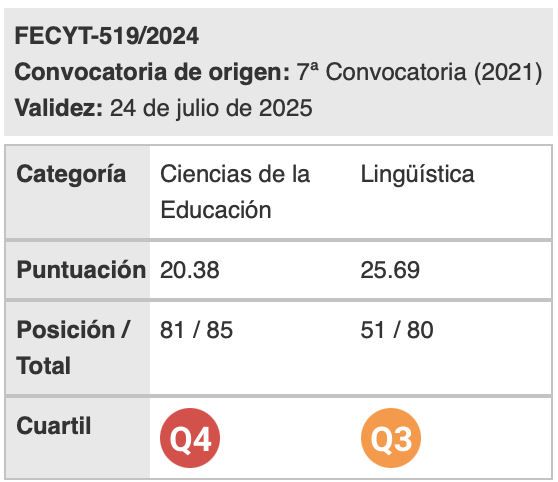Affective Variables in Second Language Acquisition and their Effect on the Spanish Academic Context
Palabras clave:
second language acquisition, affect, anxiety, learningResumen
For many students, learning a Second Language (SL) can either be a rewarding or a threatening experience. Recent studies claim that this is caused by the role that the affective domain plays in the learning process. Since the affective variables are considered the least understood by researchers in Second Language Acquisition (SLA), this paper focuses on them. The main purpose in this research is to study the connection among anxiety, attitude and motivation and their effect on the academic performance of sixty-six Spanish students who are learning English as a SL. Teachers are also observed to know to what extent they alter those students’ attitudes, feelings of anxiety and motivation towards their language classes. Since the students who take part in this research share the same teacher, other two teachers are observed in order to analyze whether they have the same effect on their students or not. Results point out that there are clear contrasts between bilingual and non bilingual students and the different performances of the three teachers who were observed.
DOI: 10.20420/rlfe.2015.0003
Descargas
Citas
Arnaiz, P. & Guillén, F. (2013). Anxiety in Spanish EFL students in different university degree programs. Anales de Psicología, 29 (2), 335-344.
Arnaiz, P. & Pérez-Luzardo, J. (2014). Anxiety in Spanish EFL university lessons: causes, responsibility attribution and coping. Studia Anglica Posnaniensia, 49 (1), 57-76.
Arnold, J. (2009). Affect in L2 learning and teaching. Estudios de lingüística inglesa aplicada, 9, 145-151.
Arnold, J. (2011). Attention to Affect in Language Learning. Anglistik. International Journal of English Studies, 22(1), 11-22.
Arnold, J. & Brown, D.H. (2000). Mapa del Terreno. En Jane Arnold (Ed.), El Dominio Afectivo en el Aprendizaje de Idiomas. Madrid: CUP.
Crookall, D. & Oxford, R. (1991). Dealing with anxiety: some practical activities for language learners and teacher trainees. In E. Horwitz, & D. Young, (Eds.), Language Anxiety. From Theory and Research to Classroom Implications (pp. 141- 150). Nueva Jersey: Prentice Hall.
Dörnyei, Z. (2006). Individual differences in second language acquisition. Association Internationale de Linguistique Appliquée Review, 19, 42-68.
Dörnyei, Z., & Skehan, P. (2003). Individual differences in second language learning. In C. J. Doughty, & M. H. Long (Eds.), The handbook of second language acquisition ( pp. 589-630). Oxford: Blackwell.
Ellis, R. (2004). Individual Differences in Second Language Learning. In A. Davies & C. Elder (Eds.), The handbook of applied linguistics (525-551). Oxford: Blackwell.
García, G. (2011). La ansiedad ante el aprendizaje de una segunda lengua. Autodidacta, 5, 41-55.
Guillén, F., Pérez-Luzardo, J. & Arnaiz, P. (2013). Relación entre motivación y optimismo disposicional en aprendices de inglés como lengua extranjera en un contexto universitario. Revista de Educación, Extraordinario, 104-128.
Horwitz, E. (2001). Language anxiety and achievement. Annual Review of Applied Linguistics, 21, 112-126.
Horwitz, E. K., Horwitz, M. B., & Cope, J. (1986). Foreign language classroom anxiety. The Modern Language Journal, 70, 125-132.
Marcos-Llinas, M. (2007). Variables afectivas en la clase de lenguas extranjeras. Interlingüística, 17, 676-678.
Ortega, C. A. (2002). Learners’ anxiety in the language classroom. In F. Molina, & G. Luque, (Eds.), Uso del inglés en el aula: Lengua, literatura y traducción (pp. 253-257). Jaén: Universidad de Jaén.
Ortega-Martín. J.L. & Villoria, J. (2004). Classroom research. In D. Madrid & N. McLaren (eds.), TEFL in Primary Education (521-550). Granada: Universidad de Granada.
Rubio, F. D. (2001). El pensamiento en la clase de inglés: Fuente de poder o vulnerabilidad. Estudios de Lingüística Aplicada (ELIA), 2, 49-56.
Rubio, F. D. (2002a). Una forma de reducir la ansiedad en los exámenes orales de inglés como lengua extranjera: técnica de reevaluación positiva. Estudios de Lingüística Aplicada (ELIA), 3, 173-185.
Rubio, F. D. (2002b). Making oral test more human and less-anxiety generating. Humanising Language Teaching Magazine (HLT), 4.<http://www.hltmag.co.uk/jul02/sart3.htm>
Rubio, F. D. (2002c). Relaxation exercises for foreign language learners. In Andrewes, S. (Eds.), ELT 2001: Just think before you do it (pp. 95-98). Granada: Gráficas Alhambra.
Rubio, F. D. (2004). La Ansiedad en el Aprendizaje de Idiomas. Huelva: Universidad de Huelva.
Scovel, T. (2000). Learning New Languages: A Guide to Second Language Acquisition. Boston: Heinle & Heinle.
Silva, R. M. (2005). La reducción de la ansiedad en el aprendizaje de una lengua extranjera en la enseñanza superior: el uso de canciones. Interlingüística, 16 (2), 1029-1039.
Sparks, R. & Ganschow, L. (1993). Searching for the cognitive locus of foreign language learning difficulties: Linking first and second language learning. The Modern Language Journal, 77, 289-302.
Stern, H. H. (1983). Fundamental Concepts of Language Teaching. Oxford: Oxford University Press.
Stevick, E.W. (1980). Teaching Languages: A Way and Ways. Rowley, MA: Newbury House.
Tsui, A.B.M. (1996). Reticence and anxiety in second language learning. Voices From the Language Classroom, 2 (4), 145-167.
Young, D. J. (1999). Affect in foreign language and second language learning: A practical guide to creating a low-anxiety classroom atmosphere. San Francisco: McGraw-Hill.
Zheng, Y. (2008). Anxiety and second/foreign language learning revisited. Canadian Journal for New Scholars in Education (CJNSE), 1 (1), 1-12.
Zubko, T. N. & Ortega M. J.L. (2013). Using emotional intelligence in secondary schools to improve academic achievement and social competence in a foreign language setting. The International Journal of Learner Diversity and Identities, 20 (1), 1-17.
Descargas
Publicado
Cómo citar
Número
Sección
Licencia
Aquellos autores/as que tengan publicaciones con esta revista, aceptan los términos siguientes:
- Los autores/as conservarán sus derechos de autor y garantizarán a la revista el derecho de primera publicación de su obra, el cuál estará simultáneamente sujeto a la Licencia de reconocimiento de Creative Commons que permite a terceros compartir la obra siempre que se indique su autor y su primera publicación esta revista.
- Los autores/as podrán adoptar otros acuerdos de licencia no exclusiva de distribución de la versión de la obra publicada (p. ej.: depositarla en un archivo telemático institucional o publicarla en un volumen monográfico) siempre que se indique la publicación inicial en esta revista.
- Se permite y recomienda a los autores/as difundir su obra a través de Internet (p. ej.: en archivos telemáticos institucionales o en su página web) antes y durante el proceso de envío, lo cual puede producir intercambios interesantes y aumentar las citas de la obra publicada. (Véase El efecto del acceso abierto).

Revista de Lenguas para fines específicos is licensed under a Creative Commons Reconocimiento-NoComercial-SinObraDerivada 4.0 Internacional License.






















